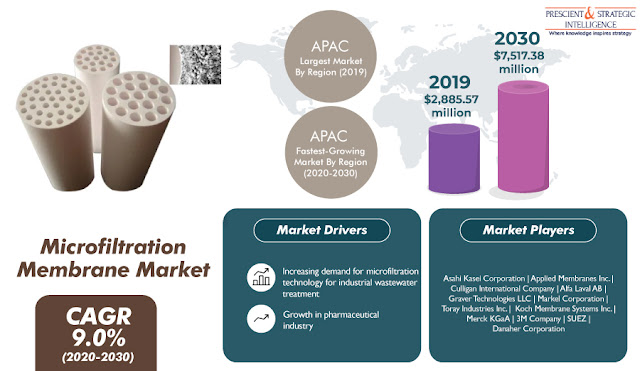
How Is Pharmaceutical Industry Supporting Microfiltration Membrane Market Growth?
The microfiltration membrane market is expected to exhibit a CAGR of 9.0% during the forecast period (2020–2030), owing to the surging usage of filtration technology in the food and beverage industry, flourishing pharmaceutical industry, and burgeoning demand for microfiltration technology for the treatment of industrial wastewater. According to P&S Intelligence, the market was valued at $2,885.57 million in 2019 and it will generate $7,517.38 million revenue by 2030. Unlike conventional separation technologies, microfiltration technologies can efficiently treat solutions containing excessive dissolved organic compounds.
One of the primary growth drivers of the market is the flourishing pharmaceutical industry. Pharmaceutical companies use an extensive volume of microfiltration membranes, such as polyethersulfone (PES), polypropylene (PP), and polyvinylidene fluoride (PVDF), for the filtration of proteins and preservatives, due to their high-flow rate, low-protein binding ability, and exceptional retention capacity. Additionally, the increasing investments being made in research and development (R&D) projects in the domain of biotechnology and medicine will also facilitate the market growth.
The application segment of the microfiltration membrane market is classified into biotechnology, dairy, food and beverage, industrial wastewater treatment, oil and gas, pharmaceutical, semiconductor and electronic, and others, such as metal and catalyst recovery and solvent recovery. Among these, the industrial wastewater treatment category generated the highest revenue in 2019, due to the increasing scarcity of usable water, rising concerns over the limited availability of water, and booming demand for safe water for commercial, industrial, and residential applications.
Geographically, the Asia-Pacific (APAC) region held the largest share in the microfiltration membrane market in 2019, owing to the escalating need for wastewater treatment, toughening regulatory standards on water treatment, and increasing desalination activities to meet the water shortage in emerging economies, such as the Philippines, India, Thailand, and China. Moreover, the soaring number of manufacturing plants and research centers of pharmaceutical and biotechnology companies will also propel the demand for microfiltration membranes in the region.
Therefore, the expanding pharmaceutical industry and burgeoning demand for uncontaminated food products and beverages will drive the demand for microfiltration membranes worldwide.
Comments